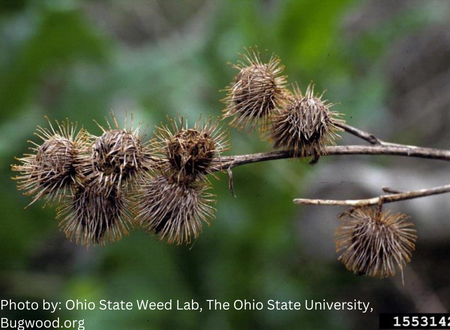Common Burdock

Common Burdock
(Arctium minus)
Priority: - Contain / Annual Control
Identification and Reproduction
Identification:
- Grows between 0.5 to 3 metres tall
- Thick, fleshy taproot
- Rosette form in first year, bolts in second year
- Stems are groved and upright in the second year, and are red towards the base of the stem
- Flowers are purple on green burs, and are about 2.5 cm in diameter
- Flowers are at ends of branched stems and bloom from July to September
- When mature, flowers are brown, circular burs that attach to animals, clothing and equipment
- First year leaves are in a rosette formation of large, heart-shaped leaves with hairy undersides and wavy edges
- Second year leaves are alternating, dark green and are on a bolting stems, have hairy undersides, and either toothed or wavy leaf margins
Reproduction:
- Reproduces soley by seed
- Disperses easily by burs that attach to humans, animals and equipment
- Seeds produced from July to Septmber, and are shed from September to the following spring
- Each plant produces between 6,000 and 16,000 seeds
Habitat & Ecology
- Commonly found in disturbed areas or in moist, fertile soils with high nitrogen contents
- Found along roads and in riparian areas
Impacts
Ecological:
- Outcompetes native vegetation, leading to losses in biodiversity
- Has allelopathic properties- burdock released chemicals that inhibit the growth of other plants
- Bats and Birds can become entangled in burrs

Economic/Social:
- Crowds out native forage species in pastures
- Taints dairy products- milk from cows consuming burdock has a bitter taste
- Burs become entangled in hair of livestock, reducing both quality and value
Management
Mechanical/Manual Control:
- Mechanical/manual control is the most effective method for controlling infestations of burdock
- Small infestations or plants can be hand pulled
- Can dig up burdock plants, being sure to remove the entire taproot
- Remove all plant materials from site, and ensure proper disposal
Chemical Control:
- Chemical control rarely used due to effectiveness of mechanical methods
- Foliar application can be used
- Most effective on first year rosettes
Resources
Header photo: Ohio State Weed Lab, The Ohio State University, Bugwood.org
You can find out more about common burdock from the Sea to Sky Invasive Species Council common burdock invasive plant page.
View the Colorado Department of Agriculture's Fact Sheet for Common Burdock here.
Find out more on common burdock from the Washington State University Whitman County Extension.





